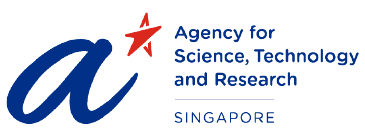Highlights
CQT researchers land on a magic wavelength for scaling atomic arrays
 CQT’s Loh Huanqian, Mohammad Mujahid Aliyu, Zhao Luheng, Yellapragada Krishna Chaitanya and Quek Xiu Quan have confirmed a ‘magic wavelength’ that can be used to scale atomic arrays. Huanqian (right) is pictured with Mujahid (left) in this photo taken in 2018.
CQT’s Loh Huanqian, Mohammad Mujahid Aliyu, Zhao Luheng, Yellapragada Krishna Chaitanya and Quek Xiu Quan have confirmed a ‘magic wavelength’ that can be used to scale atomic arrays. Huanqian (right) is pictured with Mujahid (left) in this photo taken in 2018.
CQT researchers have become the first to use a class of ‘magic wavelengths’ for atom-trapping first predicted to exist over a decade ago. The group of Principal Investigator Loh Huanqian used D1 magic wavelength optical tweezers to scale up their atom array numbers to an order of magnitude larger than was possible before. These findings are reported in a paper published 21 October in Physical Review Research.
The researchers plan to use the atom array to simulate materials and investigate many-body physics, with a long-term goal of designing advanced materials that help address global needs, for example for energy transport. Atomic arrays are also a promising platform for quantum computing.
These first results are a key step towards such applications. The work is co-authored by Huanqian along with PhD students Mohammad Mujahid Aliyu, Zhao Luheng and Yellapragada Krishna Chaitanya and former research assistant Quek Xiu Quan.
Huanqian says, “Our new technique applies to a wide range of atoms and even to optical lattices, so it can help scale up quantum simulation and quantum computation platforms with neutral atoms and molecules.”
Magic wavelengths
Researchers already knew that magic wavelengths are helpful for efficient trapping and cooling of atoms. The technique has been used in atomic clocks and for caesium atoms – a D2 magic wavelength exists only for the latter species. This work is the first to explore a D1 magic wavelength, which is predicted to occur in all alkali atoms.
“This is why the work is very significant for us,” says Mujahid, who is first author of the paper. “The hope is that our work would make it very common for people to go ahead and use the D1 magic wavelength for the alkali metals.”
D1 and D2 refer to transitions between an atom’s energy levels. Huanqian and her team looked at the ‘D1 transition’ between sodium’s ground state and one of its excited states at the next energy level.
Atomic energy levels can shift when an atom is trapped in optical tweezers, which are tightly focussed laser beams. These shifts can cause the atom’s excited state to become anti-trapping, making it challenging to cool, trap and image single atoms of light alkali metals such as potassium and sodium.
When an atom is trapped using its magic wavelength for a given transition, its levels may shift but the difference between them is unchanged. This means the cooling and imaging light remain a good match.
The researchers experimentally confirmed the D1 magic wavelength for sodium by probing the differential light shift experienced by a sodium atom in a single optical tweezer. At the predicted magic wavelength of 615.87 nm, the shift was zero.
Atoms assemble
Without magic wavelengths, another way to avoid problematic light shifts is to use ‘AC tweezers’ that alternate the trapping and cooling light – when the atom is being trapped, it is not being cooled and vice versa. However, this approach requires high optical power. The demanding power requirements affect the scalability of the systems.
With the D1 magic wavelength, the CQT researchers could develop an “all-DC” approach that uses the cooling and trapping light at the same time while also imaging the atom on the D1 transition. Compared to using AC tweezers, it requires about ten times less tweezer power. For a given laser power, the team are thus able to generate an order of magnitude more tweezers, each loaded with a single atom 80% of the time.
A larger atomic array is a better platform to investigate interesting physics while maintaining single-atom control. For instance, the light alkali atoms benefiting from the all-DC approach can be combined with a heavier element to form single molecules in tweezer arrays. A tweezer array of molecules would offer single-molecule control, while the large electric dipole moment of such molecules can give rise to rich interactions.
Mujahid says, “Our approach to use the D1 line is something that has never been shown. Now that physicists are starting to assemble different sorts of molecules that requires the use of different atomic species, we expect our technique to benefit these species.”
Arrays of light alkali metals also offer interactions using Feshbach resonances or when dressed with some Rydberg character through Rydberg dressing.
The team trapped eight atoms for this first proof-of-principle test. The next step will be to induce interactions while working towards scaling up the arrays further.
Learn more
Related Stories
Researcher recognised as one of 15 rising talents worldwide February 12 2020 | |
Experiments reveal new potential for cold atoms in quantum simulation September 06 2018 | |
CQT’s Loh Huanqian a global thought-leader on quantum computing November 19 2019 |






